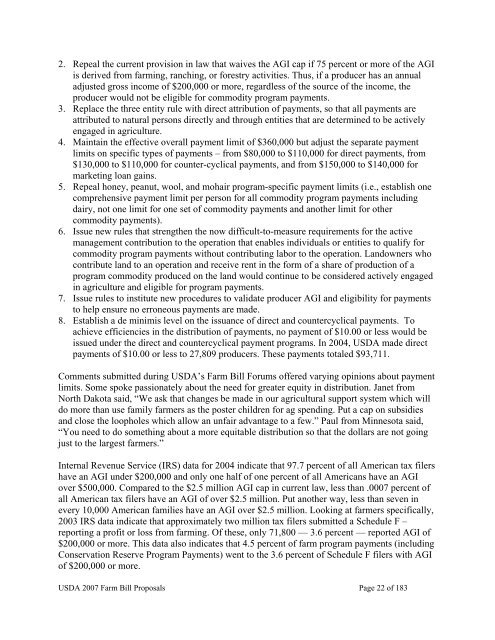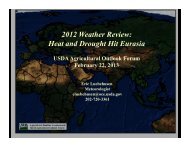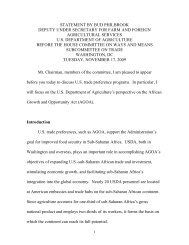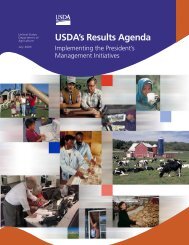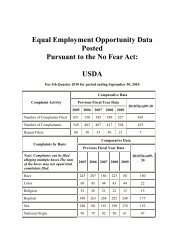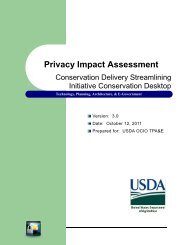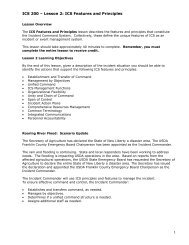USDA 2007 Farm Bill Proposals - US Department of Agriculture
USDA 2007 Farm Bill Proposals - US Department of Agriculture
USDA 2007 Farm Bill Proposals - US Department of Agriculture
You also want an ePaper? Increase the reach of your titles
YUMPU automatically turns print PDFs into web optimized ePapers that Google loves.
2. Repeal the current provision in law that waives the AGI cap if 75 percent or more <strong>of</strong> the AGIis derived from farming, ranching, or forestry activities. Thus, if a producer has an annualadjusted gross income <strong>of</strong> $200,000 or more, regardless <strong>of</strong> the source <strong>of</strong> the income, theproducer would not be eligible for commodity program payments.3. Replace the three entity rule with direct attribution <strong>of</strong> payments, so that all payments areattributed to natural persons directly and through entities that are determined to be activelyengaged in agriculture.4. Maintain the effective overall payment limit <strong>of</strong> $360,000 but adjust the separate paymentlimits on specific types <strong>of</strong> payments – from $80,000 to $110,000 for direct payments, from$130,000 to $110,000 for counter-cyclical payments, and from $150,000 to $140,000 formarketing loan gains.5. Repeal honey, peanut, wool, and mohair program-specific payment limits (i.e., establish onecomprehensive payment limit per person for all commodity program payments includingdairy, not one limit for one set <strong>of</strong> commodity payments and another limit for othercommodity payments).6. Issue new rules that strengthen the now difficult-to-measure requirements for the activemanagement contribution to the operation that enables individuals or entities to qualify forcommodity program payments without contributing labor to the operation. Landowners whocontribute land to an operation and receive rent in the form <strong>of</strong> a share <strong>of</strong> production <strong>of</strong> aprogram commodity produced on the land would continue to be considered actively engagedin agriculture and eligible for program payments.7. Issue rules to institute new procedures to validate producer AGI and eligibility for paymentsto help ensure no erroneous payments are made.8. Establish a de minimis level on the issuance <strong>of</strong> direct and countercyclical payments. Toachieve efficiencies in the distribution <strong>of</strong> payments, no payment <strong>of</strong> $10.00 or less would beissued under the direct and countercyclical payment programs. In 2004, <strong><strong>US</strong>DA</strong> made directpayments <strong>of</strong> $10.00 or less to 27,809 producers. These payments totaled $93,711.Comments submitted during <strong><strong>US</strong>DA</strong>’s <strong>Farm</strong> <strong>Bill</strong> Forums <strong>of</strong>fered varying opinions about paymentlimits. Some spoke passionately about the need for greater equity in distribution. Janet fromNorth Dakota said, “We ask that changes be made in our agricultural support system which willdo more than use family farmers as the poster children for ag spending. Put a cap on subsidiesand close the loopholes which allow an unfair advantage to a few.” Paul from Minnesota said,“You need to do something about a more equitable distribution so that the dollars are not goingjust to the largest farmers.”Internal Revenue Service (IRS) data for 2004 indicate that 97.7 percent <strong>of</strong> all American tax filershave an AGI under $200,000 and only one half <strong>of</strong> one percent <strong>of</strong> all Americans have an AGIover $500,000. Compared to the $2.5 million AGI cap in current law, less than .0007 percent <strong>of</strong>all American tax filers have an AGI <strong>of</strong> over $2.5 million. Put another way, less than seven inevery 10,000 American families have an AGI over $2.5 million. Looking at farmers specifically,2003 IRS data indicate that approximately two million tax filers submitted a Schedule F –reporting a pr<strong>of</strong>it or loss from farming. Of these, only 71,800 — 3.6 percent — reported AGI <strong>of</strong>$200,000 or more. This data also indicates that 4.5 percent <strong>of</strong> farm program payments (includingConservation Reserve Program Payments) went to the 3.6 percent <strong>of</strong> Schedule F filers with AGI<strong>of</strong> $200,000 or more.<strong><strong>US</strong>DA</strong> <strong>2007</strong> <strong>Farm</strong> <strong>Bill</strong> <strong>Proposals</strong> Page 22 <strong>of</strong> 183


